- Quesillo, the Cradle of Maize, pre-Colonial Nicaragua, Güiligüiste and Acacia
- The Cradle of Maize Evolution
- Western Nicaragua before Columbus Sailed the Ocean Blue
- Quesillo Güiligüiste and Quesillo Acacia: Two Restaurants with the Same Specialty
- About the Recipe
- The Tortilla
- Preparing the Quesillo
- Our Take on the Recipe
There is more to quesillo than meets the eye.
What other street food has ignited a bitter battle of words between two townships? Both claim to be the birthplace of this popular, cheesy morsel. At the heart of the feud lie two restaurants, eat with their own claim to its creation.
But there can only be one origin story for this troublemaking treat. Or can there?

Quesillo, the Cradle of Maize, pre-Colonial Nicaragua, Güiligüiste and Acacia
Before we dive in to the bitter rivalry sparked by a cheese stuffed tortilla, we should understand a brief history of Nicaraguan gastronomy, and the key ingredients to this week’s dish.
So let’s dust off the ol’ history books and dive right in to how corn tortillas and cheese came to be in Nicaragua.
The Cradle of Maize Evolution
While there is room for argument about quesillo, there is no arguing about one of its main ingredients, corn. Corn is ubiquitous. We use corn for food, feed, fuel, bio-chemicals, ornamentation, and the list could go on and on.
Until the 1930s, little was known of corn’s origin. It was clear that the people indigenous to the Americas had domesticated the crop. But it was unclear from what plant corn descended.
In the early 1900s, a group of scientists believed they identified this mysterious maize ancestor. Teosinte, a type of Mexican grass that was originally categorized as a type of rice. But the technology to prove their hunch did not yet exist in the early twentieth century.
Leave it to George W. Beadle, a graduate student at Cornell University in the early ’30s, to sort out the great mystery of this staple of our global economy. Fortunately for corn history enthusiasts everywhere, Dr. Beadle was a geneticist.
Dr. Beadle learned that teosinte and corn had similar chromosomes. Furthermore, he created hybrids between the two plants that looked like an intermediary between teosinte and corn (think: the missing link!).
Three decades after his corn popping proposal, there was still doubt about the link between corn and teosinte. Dr. Beadle dove in deeper with his genetic analysis and was able to prove distinctively the relation between the two plants. Eureka!
There remained but one problem. No one had yet proven where corn was first domesticated. Enter the University of Wisconsin botanists!
The botanists compared teosinte from all over the western hemisphere with every known variety of maize. They found that all maize was genetically similar to a single type of teosinte that grows in the Central Balsas River Valley of southern Mexico.
This region was dubbed the cradle of maize evolution. Cue lights, cue music…
Further research conducted in this region determined that the region’s inhabitants first began to domesticate teosinte in approximately 9,000 BC.
Remarkable to think that these ancient humans, some of the first to domesticate plants, created a crop that would dominate the globe in thousands of years. We are thankful that they did, for their hard work has brought so many incredible corn based dishes out of Central and South America to the world, such as Arepas Rellenas and Pastel de Choclo.
Western Nicaragua before Columbus Sailed the Ocean Blue
Now that we are all well versed in the ancient evolutionary history of corn, let’s time hop forward a few millennia to approximately 1,000 B.C.E. And let’s travel a bit further south than Mexico to, say, Nicaragua?
There are dig sites in Southern Nicaragua that show that early inhabitants there made pottery, and, you guessed it, cultivated maize. Three thousand years of corn cultivation in Nicaragua!
Archeological and anthropological evidence suggests that the peoples living in western Nicaragua during the arrival of the Spanish conquistadors in the sixteenth century had resided there for several centuries. And they were, of course, cultivating corn as one of the staples of their diet.
We know that one of the two main ingredients in Quesillo has been in Nicaragua for three millennia. But what about the second ingredient, the queso?
Unlike corn, cattle have only been in Nicaragua for the last 500 years. They were first introduced by the Spaniards, who, like many colonizers, were so into their milk, cheese, and beef, they were willing to spend a month on a ship with a couple of cows.
After the arrival of the colonizers and the cows, livestock began to take hold of the economy. Léon, the colonial capital of Nicaragua (and incidentally the region in which our two feuding towns are located) came under the control of a wealthy elite whose income was based primarily on livestock.
And now we can finally fast forward a few centuries to the twentieth. The century that brought us the street food known as quesillo, the feisty little street treat that started the feud in western Nicaragua.
Quesillo Güiligüiste and Quesillo Acacia: Two Restaurants with the Same Specialty
Separated by a mere ten miles, the small townships of La Paz Centro and Nagarote lie at the center of this feud. Both towns claim to be the cradle of the quesillo. If only the Dr. Beadle was around to solve this mystery!
The first commercial appearance of the quesillo was in the early twentieth century at the now defunct train stations in La Paz Centro and Nagarote. Their first saleswoman, and legendary innovator, was a woman named Señora Socorro Munguía Madriz.
Señora Madrid was born in Nagarote, but it is said she created quesillos in La Paz Centro. She and the Rueda sisters sold the quesillos in the train stations to travelers, and eventually opened a restaurant in La Paz Centro dedicated to their tortilla and cheese creation, Quesillo Güiligüiste (wil-ee-wee-stay).
In what could only have been an effort to further complicate the matter, Doña Dalila Lara, who owned Quesillo Güiligüiste in the 1960s, sold her business and moved to Nagarote, where she opened Quesillo Acacia.
The result of this torrid past is the feud between La Paz Centro and Nagarote. Both towns claim that the popular dish was created in their township.
Apparently this little duel is no laughing matter, women selling quesillos on the busses yell insults at one another. Isn’t food supposed to bring us together?
This feud has even reached the highest levels of local government. In 2006 La Paz Centro launched a challenge to create the large quesillo cheese braid. Nagarote responded with their own competition in 2008. La Paz Centro countered in 2012. It’s high time for another giant cheese building competition!
Inhabitants of the two towns each say that their nuanced approach to the quesillo is the best way. We say, there is only one way to find out.

About the Recipe
When it comes to preparing quesillo, there are two ways to prepare it: the easy way and the easier way. The difference between the two is whether or not you’d like to create your own tortilla from scratch or not.
The Tortilla
For us personally, making the homemade tortilla is half the magic in quesillo, and that it’s so incredibly easy to do makes it even more attractive. Not only do you have more control over the ingredient quality going into the overall quesillo, but it can be a fun activity to do with your friends and family too. There’s something to be said of every person enjoying the fruits (and tortillas!) of their own labor.
Let’s start with the tortilla then. In general, tortillas have two key ingredients: water and a grounded starch like corn or wheat. For quesillo, corn tortillas are the way to go, so the recipe will call for masaharina, otherwise known as ground corn flour.

You’ll take the corn flour into a mixing bowl, gradually add in your water, and mix the two together well with a ladle or sturdy spoon. At first, the dough will be pretty mealy and lumpy, but enough stirring will eventually bind it all together into a smoother form. If you’d like, you can even shape your dough into a more organized ball form.
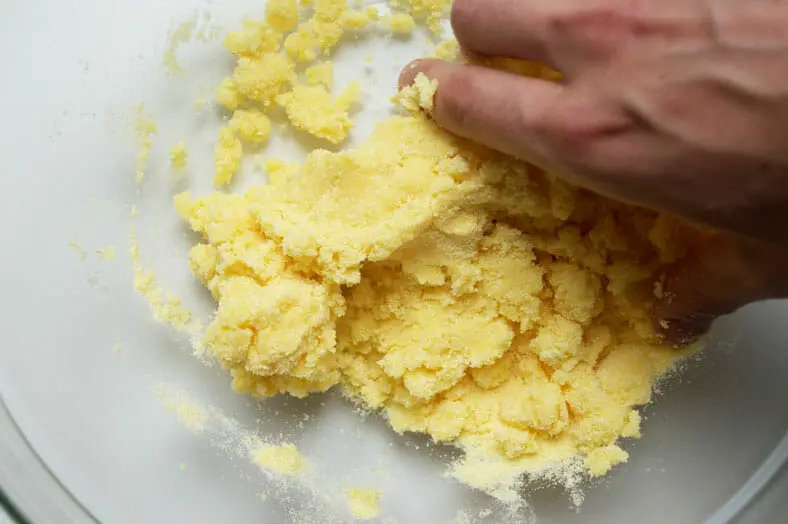
Depending on your own preferences, you can add some other ingredients to your tortilla dough. You’ll see in this recipe that we added a few ingredients of our own, but it’s completely up to you to decide how you want to influence the taste of your tortilla. If you do add other ingredients, though, do be sure that everything has been ground down into a pasty or fine-ground texture.

Once you have your dough, you’ll tear off a small piece of it (or use a ice cream scoop or large melon baller for more uniform tortillas) and roll it into the shape of a ball in the palm of your hands. If you have a tortilla press handy in the kitchen, that’s great and makes flattening the ball even easier, but it’s not a required kitchen tool. An easy do-it-yourself way to get a perfectly flat tortilla is by taking a large gallon-sized Ziploc bag, cutting the sides of the bag and brushing the inside of the bag with olive oil. Place your tortilla ball in the middle of one side of the bag, fold the other side over top of the ball, and press down hard.
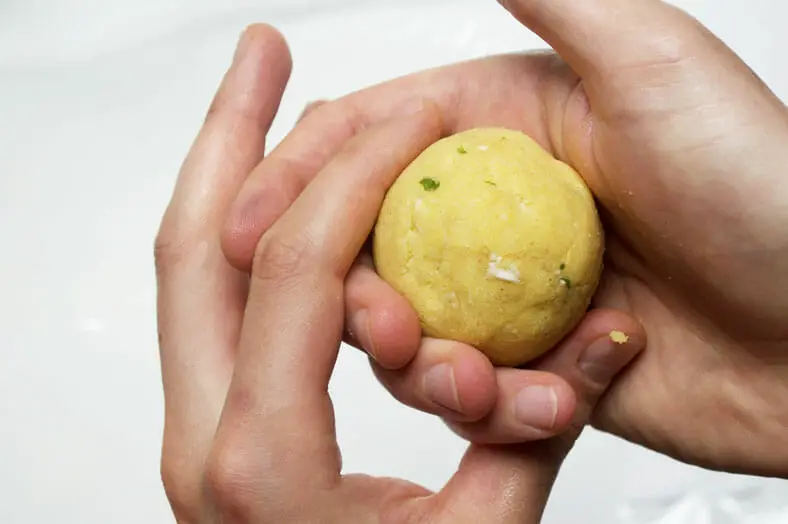
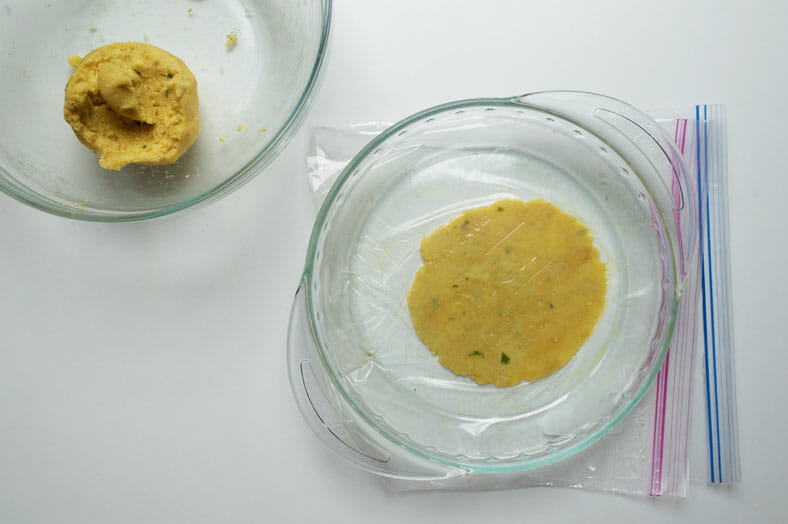

Preparing the Quesillo
With flat tortilla in hand, place your tortilla in a piping-hot dry pan, griddle or skillet over medium-heat. Cooking the tortilla on the first side won’t take very long (1-2 minutes max), so stay close by the pan.

When it is time to flip, you’ll then take your soft white cheese and place it directly onto the quesillo. The cheese will melt beautifully across one side of your quesillo as the other side cooks.

After another 1-2 minutes and once the cheese has melted, take your quesillo off the pan and directly into your serving tray. It’s common to find quesillo served in plastic bags to retain any leftover juices and flavors that might slip out, but even using something like aluminum foil as your “plate” (or even a plate itself) is totally fine as well.
Finish off your quesillo by garnishing it with the likes of pickles onions, sour cream or anything else, and dig in!
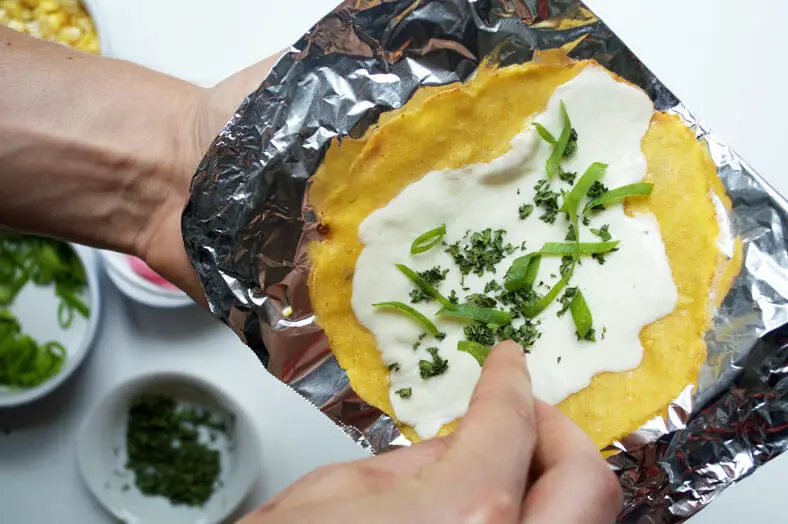
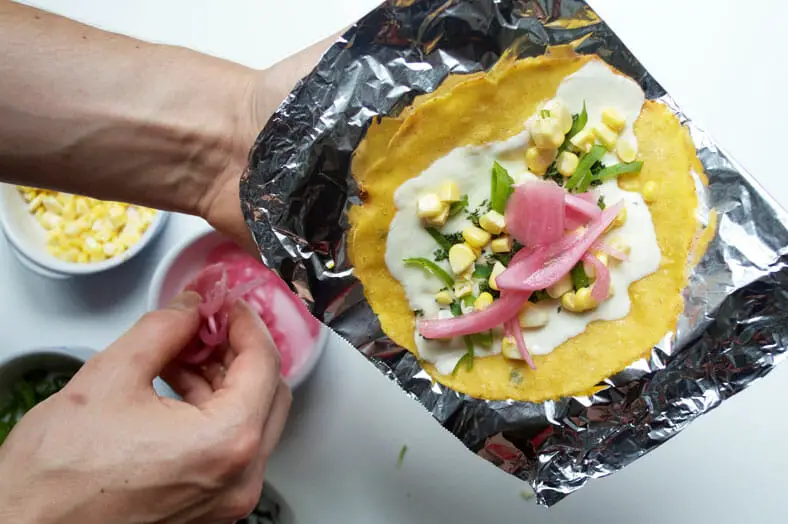
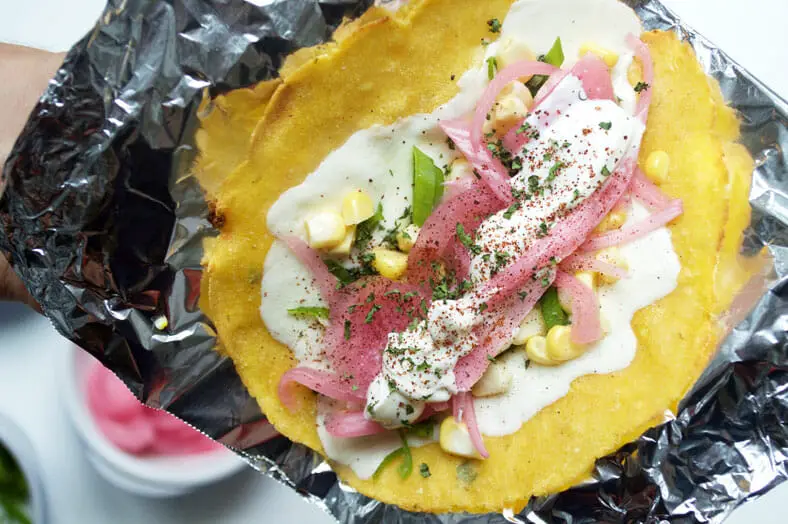
Our Take on the Recipe
Quesillo was a really fun recipe to develop, and it’s clear that we’re not the only ones that think so. There are a wealth of recipes for unique types of quesillo out there, but ultimately we opted to keep it fairly simple in our own version. We chose this recipe as our reference since it was as simple as it got, and we built up what we needed from there.
One of the biggest changes we were forced to make, however, was the use of cheese. Alas, we couldn’t find the traditional queso seco Nicaraguense that usually goes into this recipe here in the US. It’s a shame, too, since it has a very special salty, almost-smoky flavor to it that adds a special taste to quesillo. Feta is slightly on par with it’s flavor, but it’s still very different too.
In the absence of this primary cheese, we decided not to make a substitute with feta and instead go with mozzarella. The flavors of mozzarella are more subdued than both feta and queso seco, but it melts so consistently and can leave the door open for other flavors to stand out in the profile.
For the tortilla, we did add some additional ingredients into a tortilla dough that we made from scratch. We cut off the kernels from a fresh ear of corn and blitzed it in a food processor (on Amazon) with chipotle chili powder and scallions to create a flavorful paste to integrate it into the dough. It was a great add and we’re personally really pleased with it, but keep in mind that this is not traditional and is entirely optional in your own version of quesillo.
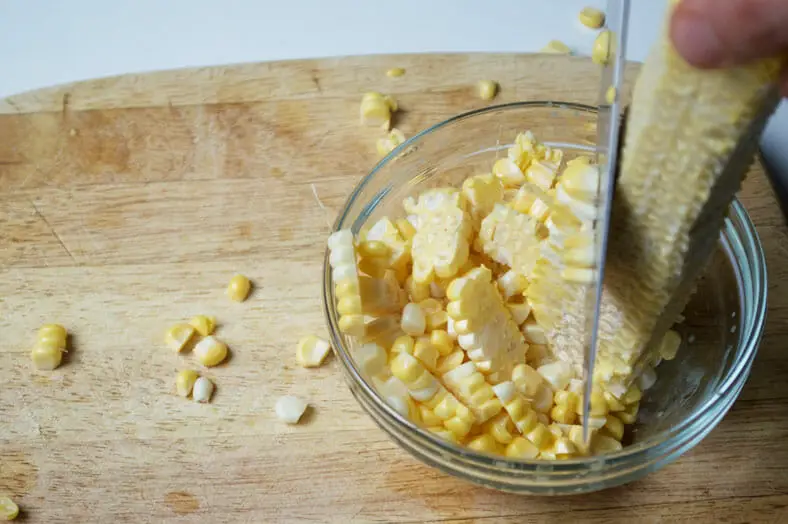
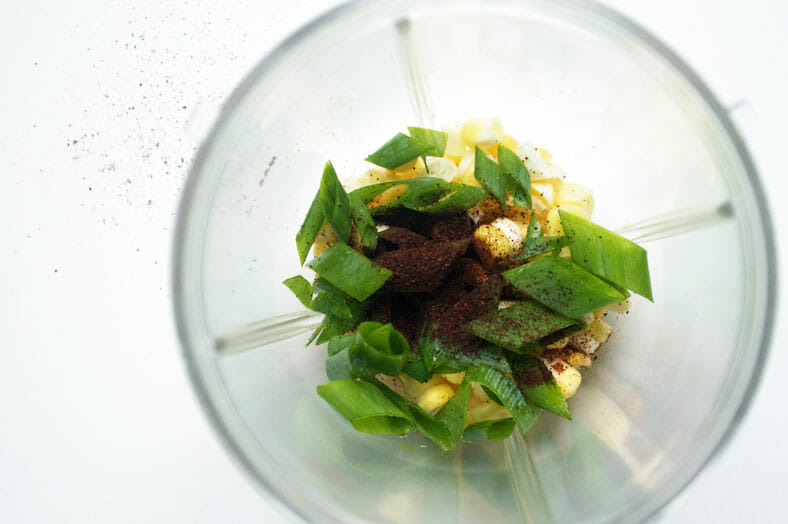

Finally, we made some adjustments on the garnish side as well. We put in dollops of Greek yogurt instead of sour cream for its slight added health benefit, and we sprinkled chopped cilantro over top of our finished products too.
Regardless of what you choose to do, though, any type of quesillo will come out incredibly delicious and addicting. And because it’s so simple, quick and fun to make, this recipe is a real winner.
Enjoy!
What would you garnish your quesillo with? Comment below!


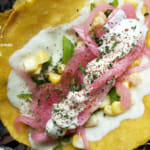
QUESILLO: NICARAGUAN TORTILLA AND CHEESE STREET FOOD
- Total Time: 25 minutes
- Yield: 8 Quesillo 1x
Ingredients
- 1 cup masaharina flour or cornmeal
- ⅔ cup cold water
- 1 ear of corn, the kernels cut from the cob (not traditional, but tasty and optional)
- 1 teaspoon chili powder
- 1 stalk scallion, roughly chopped
- Less than a tablespoon of coconut oil
- 5 oz mozzarella
- Finely chopped onions pickled in vinegar
- ¼ cup Greek yogurt
- 1 handful fresh cilantro, roughly chopped
- Salt and pepper to taste
Instructions
- Take a medium sized bowl and add your cornmeal
- Make a small well in the middle and pour in your water
- Either with a ladled spoon or your hands, mix the cornmeal and water around as they combine. At first, it will start to become mealy and clumpy, but it will eventually mix together into a large ball
- In a blender or food processor (on Amazon), combine your scallions, corn and chili powder with a small dollop of oil. Grind the ingredients into a paste, then add into the bowl with the cornmeal and water
- Mix your entire quesillo batter around until everything has been well mixed with one another. Shape the batter into a large ball
- From your larger ball of quesillo batter, tear off a small piece to mold into a ball in the palm of your hands
- Next, flatten your smaller ball of batter and flatten it to as thin a flatbread as you can. One way to do this (that is easy and that we would suggest) is to take a Ziploc bag, grease it with olive oil on the inside, then cut down the sides to let it open lengthwise
- Put your dough in the middle of the bag, cover it with the other side of the bag, then press down as hard as you can (even with a book!)
- Take a griddle or a flat pan over medium-high heat and let it get piping hot
- When piping hot, add the tiniest bits of oil, then take your flattened quesillo tortilla and place onto the pan
- Let your quesillo cook for 1-2 minutes on the first side, then flip
- Immediately as you flip your quesillo, add your mozzarella onto the quesillo and let it melt
- After another 1-2 minutes, take your quesillo off the griddle. Garnish your melted mozzarella with your pickled onions and cilantro, and enjoy!
- Prep Time: 10 min
- Cook Time: 15 min

